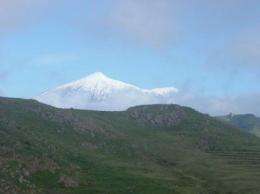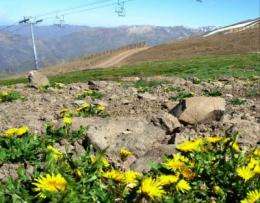Mountain plants unable to withstand invasion

An international research team has studied the distribution of plant species in mountainous environments. The study shows that mountain plant communities are not particularly resistant to invasion by exotic species. The scientists also warn that these may become more aggressive as global warming gets a grip.
In 2005, scientists from various science centres in Spain, Germany, Switzerland, Australia, the United States and Chile created the Mountain Invasion Research Unit (MIREN) in order to study the distribution of exotic species in high mountain species and to design experiments to confirm the invasive capacity of certain species in high mountain environments.
"These plant communities in Alpine environments have until now not been thought particularly vulnerable to this kind of environmental disturbance", José Ramón Arévalo, one of the authors of the study and a researcher at the Department of Ecology of the University of La Laguna, tells SINC. However, the experiments show clearly "that the beliefs about this supposed protection and mountain species' resistance to invasive species is erroneous", he adds.
The study, published recently in Frontiers in Ecology and The Environment, and which is part of the work done by MIREN, has made it possible to identify the factors that make plants in these areas more vulnerable to invasion by other species.

Among other factors, the scientists stress the ease of movement of propagules (plants which can reproduce asexually in order to produce new plants) as a result of human activity and the increase in environmental disturbance, the low levels of biological resistance of invaded plant communities, the increase in transport between high mountain areas that are far apart from each other, and the risks according to climate change models, "which will make it easier for invasive plants to establish themselves and reproduce", the ecologist explains.
A work agenda to stem invasions
The work carried out over the last five years shows that "invasions may be a factor in more extensive and serious disturbance than had ever been thought", says Arévalo. The scientists also say there is a need to establish a work agenda to evaluate "not only current invasions, but also those that could happen in the future in mountainous environments", warns the researcher.
Protecting against and above all preventing invasions could be done by means of experimental and modelling work. Arévalo says "biological invasion is not a fact, but rather a process of species overlapping within a habitat, which means prevention is much more effective and viable than eradication".
More information: Pauchard, Anibal; Kueffer, Christoph; Dietz, Hansjoerg; Daehler, Curtis C.; Alexander, Jake; Edwards, Peter J.; Arévalo, José Ramón; Cavieres, Lohengrin A.; Guisan, Antoine; Haider, Sylvia; Jakobs, Gabi; McDougall, Keith; Millar, Constance I.; Naylor, Bridgett J.; Parks, Catherine G.; Rew, Lisa J.; Seipel, Tim. "Ain't no mountain high enough: plant invasions reaching new elevations" Frontiers in Ecology and The Environment 7(9): 479-486 Nov 2009.
Provided by FECYT - Spanish Foundation for Science and Technology















